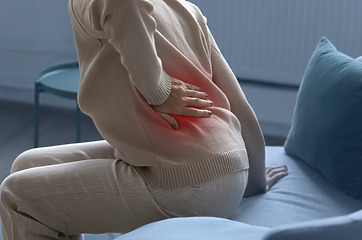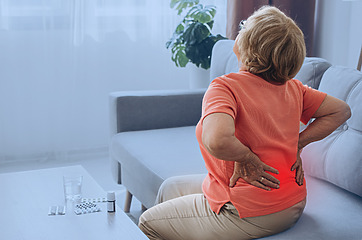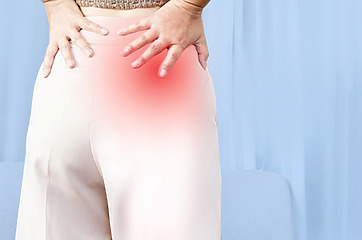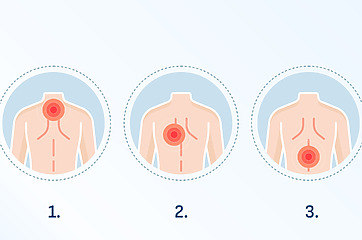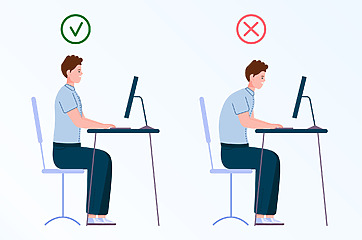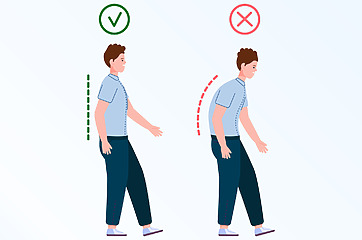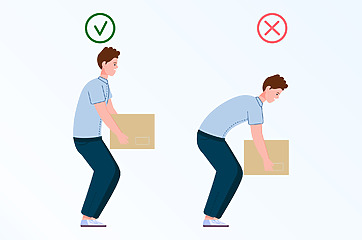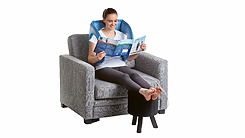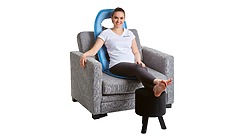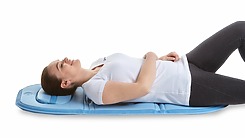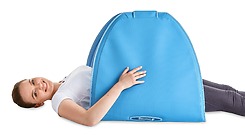Biomag - Encyclopedia - Spinal pain
Spinal pain - symptoms, description and treatment
Revision
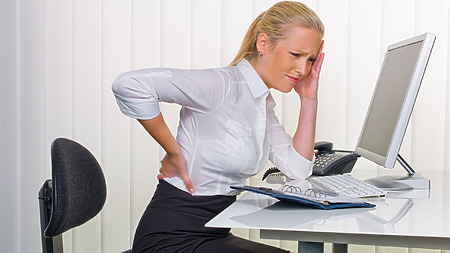
Does your back hurt? Do you have problems with walking, getting up and almost any movement? Spinal pain can make everyday activities unpleasant. The causes and type of pain are very varied and more severe spinal problems can lead to disability.
Find out what the causes of spinal pain are and what treatment options exist. How to suppress unpleasant spinal pain? Read more here.
Spinal pain: What do typical disorders look like
- Back stiffness around the spine
- Restriction of movement
- Incorrect posture caused by pain
- Muscle cramps [1]
Limited mobility is common for patients who have inflammation in the joints. Spinal pain may be accompanied by weakness and tingling in the legs or pain in the buttocks. The burning pain in the arm from the spine is no exception. Some patients even complain of abdominal pain from the spine, which may be related to oppression of the nerves around the spine. [2]

Only a doctor can make a correct diagnosis. Do not use this or any other article on the internet to make a diagnosis. Don’t put off seeing a doctor and address your condition early.
Description and causes of spinal pain
What is spinal pain?
Spinal pain can occur anywhere in the back – from the cervical spine to the lower back. It can be mild and last only a short time, in other cases the pain is severe and troubles patients for a long time. Spinal pain can occur after a strain, a fall or a sudden movement, but in some cases the reason for the pain is not obvious. It may also be related to a chronic disease. [3]
Types of spinal pain
Back and spinal pain can vary in character (sharp, dull, burning) and in duration (acute or chronic).
Acute back pain- usually lasts 1-2 weeks. The cause of pain is usually inflammation, an injury such as a muscle injury, an illness or a medical procedure. It will subside after the cause of the pain is resolved.
Chronic back pain – lasts for months or even years. It may ease and return repeatedly, or last throughout the duration of the trouble. It often accompanies some chronic disease, such as arthritis. It fundamentally disrupts the quality of life. [4]
Causes of spinal pain
- Spinal pain can be related to changes in muscle tension in the back, long-term overloading of the spine or a prolapsed intervertebral disc.
- Spinal pain can be the result of degenerative changes associated with older age.
- Pain in the lumbar spine often comes from inflammation of the sciatic nerve (sciatica).
- Pain in the sacrum also often arises as a result of improper lifting of heavy objects.
- Pain in the thoracic spine is often related to poor posture or to joint and muscle disorders or injuries.
- Less common causes of spinal pain include: rheumatoid arthritis, osteoporosis, cancer, infectious diseases. [5],[6]
Factors that contribute to spinal pain
Many factors are involved in the development of spinal pain.
- An unhealthy lifestyle with excess weight and lack of physical activity plays a big role.
- The spine does not benefit from sedentary jobs or activities that require handling heavy loads.
- Pain can also occur as a result of a previous injury. Heredity and family history of spinal disorders also play a role. [7]
- A blocked back or cervical spine can also just be the result of a poor sleeping position or a poor quality mattress.
Diagnostics
A proper diagnosis is usually necessary for spinal pain if the pain lasts for more than two weeks and the condition does not improve. In most cases, the pain subsides during this time.
What is the procedure if you go to the doctor with spinal pain?
- The doctor will ask in detail about the type of pain and situations when the pain appears or worsens.
- A physical examination is important, during which the doctor checks the range and limitation of movement or detects pain and tenderness.
- The imaging methods used for spinal pain are X-ray, MRI and CT. Thanks to them, the doctor can assess the condition of the vertebrae and surrounding tissues and determine the cause of the pain and treatment. [8] ,[9]
Did you know?
- Eight out of 10 people will experience lower back pain in their lifetime. [10]
- Chronic back pain may be related to smoking. Smoking impairs the transfer of oxygen and nutrients to the tissues, weakening the muscles in the back. [11]
Complications when left untreated
If spinal pain is not treated early and correctly, various complications can develop.
- If spinal pain lasts a long time and is not properly addressed, it can become chronic.
- Gradually, movement in the affected area of the spine may be restricted, which can affect the ability to carry out normal daily activities.
- Without proper care and rehabilitation, the muscles around the affected area may be weakened or shortened.
- Chronic inflammation in the spine can contribute to the development of arthritis.
Chronic pain
Restricted mobility
Muscle weakness
Arthritis

We recommend not postponing the treatment of spinal pain
Do not delay treatment for spinal pain and see a specialist if you have any health problems or doubts about your health. This will prevent unnecessary health complications.
Therapy of spinal pain
Spinal pain is usually treated conservatively, i.e. without surgery. After the examination, the patient will learn what will bring pain relief in a given situation and how to proceed to prevent the recurrence of the problem. [12]
The patient should remain reasonably active despite the pain – bed rest should not last more than 1-2 days. Prolonged passivity can contribute to muscle stiffness and prolong the duration of pain.
- Relief from discomfort in the first few days is brought by painkillers and inflammatory drugs or muscle relaxants.
- In some cases, spray is used – injecting painkillers or anti-inflammatory drugs directly into the back.
- The patient should follow instructions on how to sit, lie and move correctly.
- Cold or warm compresses can also be used to relieve pain and inflammation.

Beware
Treatment for spinal pain can only be determined by your doctor after considering your overall health. Therefore, do not use this article as a guide to treatment, which can only be determined by a doctor.
Physiotherapy
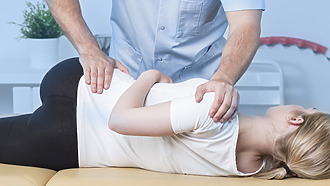
Not treating (popularly called “passing on”) spinal pain and not following recommendations on how to care for your back can lead to long-term problems. Physiotherapy plays an important role in the treatment of spinal pain and serves primarily as a prevention of further problems.
- Under the guidance of a physiotherapist, patients learn how to properly strengthen and stretch their muscles or improve their movement habits.
- The physiotherapist uses various techniques and aids to relieve back pain and stiffness and restore mobility.
[13]
,[14]
Surgical treatment options
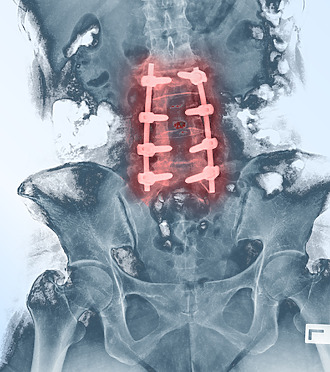
Surgery is used, for example, in patients who need to stabilise their vertebrae or remove part of a herniated disc.
However, surgery on a herniated intervertebral disc will only resolve the problem in one in ten patients. Spinal surgery (spinal surgery) uses many different types of surgery and procedures are constantly being improved. [15],[16]
Prevention: ergonomic measures protect the back
Prevention of spinal pain and the development of chronic pain is mainly based on lifestyle changes and ergonomic measures. Long-term spinal care can be summarised in 10 points:
Lifestyle
- Engage in regular physical activity to strengthen your muscles and improve spinal stability.
- Choose sports that do not strain your back – swimming, cycling, fast walking.
- Stop smoking.
- Try to limit stressful situations – stress results in increased muscle tension.
- Maintain the right body weight. [17]
Ergonomics
- Make sure you have the right posture.
- When lifting heavy loads, firm the abdomen. Do not bend your back, but lift the load from a squatting position.
- When sitting, use a back support to give your spine proper support.
- Intersperse long periods of sitting or standing with breaks and change position as often as possible.
- Arrange your desk or workstation so that you don’t stretch, turn or bend unnecessarily. [18]
Alternative treatment for spinal pain
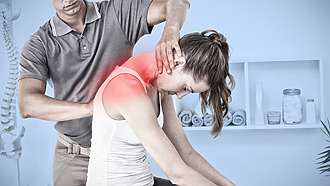
Alternative treatments for spinal pain include acupuncture, massage or chiropractic.
Acupuncture can provide pain relief for some types of spinal pain and promote back mobility. Some patients, on the other hand, prefer massages that relieve muscle tension. Another possible treatment is chiropractic, which is the use of manual techniques to unblock the spine. Due to the possible side effects of spinal manipulation, it is necessary to carefully select a workplace where only experts in this field are present. [19]
Spinal pain can be related to inflammation, so an anti-inflammatory diet can also be tried.
What foods have anti-inflammatory effects?
- Selected vegetables (e.g. carrots, leafy greens, blueberries, sweet potatoes, tomatoes),
- fatty fish (salmon, sardines, mackerel),
- healthy fats found in avocados or olive oil, nuts (almonds, walnuts, sunflower and pumpkin seeds).

Important information when dealing with spinal pain
- Spinal pain can be related to an injury, long-term back strain or chronic musculoskeletal disease.
- Spinal pain appears most often in the cervical and lumbar region.
- In contrast, thoracic spine pain is less common.
- Pain management in the acute phase involves, for example, the use of pain relievers to reduce muscle tension.
- Regular exercise and back care are important in the long term.
Summary and recommendations for the management of spinal pain
See a doctor
Treatment for spinal pain is always determined by a doctor based on a general examination, an assessment of your health and an accurate diagnosis.
Causal treatment of spinal pain
After a general examination, your doctor will recommend treatment for the cause of your spinal pain. They will also advise you on possible lifestyle adjustments and the next course of action.
Relieving pain, swelling and inflammation
Symptomatic treatment focuses on the manifestations or signs (symptoms) of the disease. Such treatment can significantly improve your quality of life and support comprehensive treatment during the course of the disease.
Sources, references and literature
[1] Spinal Pain. American Association of Neurological Surgeons. Available at: https://www.aans.org/en/Patients/Neurosurgical-Conditions-and-Treatments/Spinal-Pain
[2] Tidy C. Back and Spine Pain. Patient.info, 16. October 2020. Available at: https://patient.info/bones-joints-muscles/back-and-spine-pain
[3] Tidy C. Back and Spine Pain. Patient.info, 16. October 2020. Available at: https://patient.info/bones-joints-muscles/back-and-spine-pain
[4] Chronic pain. Johns Hopkins Medicine. Available at: https://www.hopkinsmedicine.org/health/conditions-and-diseases/chronic-pain
[5] Tidy C. Back and Spine Pain. Patient.info, 16. October 2020. Available at: https://patient.info/bones-joints-muscles/back-and-spine-pain
[6] Wheeler T. Common Spine Problems. WebMD, 19. February 2023. Available at: https://www.webmd.com/back-pain/ss/slideshow-spine-problems
[7] What is Spine Pain? Intermountain Health, 2017. Available at: https://intermountainhealthcare.org/services/pain-management/conditions/back-and-spine-pain/spinal-pain/
[8] Spinal Pain. American Association of Neurological Surgeons. Available at: https://www.aans.org/en/Patients/Neurosurgical-Conditions-and-Treatments/Spinal-Pain
[9] Tidy C. Back and Spine Pain. Patient.info, 16. October 2020. Available at: https://patient.info/bones-joints-muscles/back-and-spine-pain
[10] Tidy C. Back and Spine Pain. Patient.info, 16. October 2020. Available at: https://patient.info/bones-joints-muscles/back-and-spine-pain
[11] 10 alternative back pain treatments to try before choosing surgery. UT Southwestern Medical Center, 20. September 2018. Available at: https://utswmed.org/medblog/alternative-back-pain-treatment/
[12] What is Spine Pain? Intermountain Health, 2017. Available at: https://intermountainhealthcare.org/services/pain-management/conditions/back-and-spine-pain/spinal-pain/
[13] Spinal Pain. American Association of Neurological Surgeons. Available at: https://www.aans.org/en/Patients/Neurosurgical-Conditions-and-Treatments/Spinal-Pain
[14] What is Spine Pain? Intermountain Health, 2017. Available at: https://intermountainhealthcare.org/services/pain-management/conditions/back-and-spine-pain/spinal-pain/
[15] Tidy C. Back and Spine Pain. Patient.info, 16. October 2020. Available at: https://patient.info/bones-joints-muscles/back-and-spine-pain
[16] What is Spine Pain? Intermountain Health, 2017. Available at: https://intermountainhealthcare.org/services/pain-management/conditions/back-and-spine-pain/spinal-pain/
[17] Spinal Pain. American Association of Neurological Surgeons. Available at: https://www.aans.org/en/Patients/Neurosurgical-Conditions-and-Treatments/Spinal-Pain
[18] How to Save Your Back. UCLA Ergonomics. Available at: https://ergonomics.ucla.edu/backsafety/how-to-save-your-back
[19] Spinal Manipulation: What You Need To Know. National Center for Complementary and Integrative Health, 2017. Available at: https://www.nccih.nih.gov/health/spinal-manipulation-what-you-need-to-know
| Rate this article |
|
|
4/52 Reviewed by
|
How to control pain, swelling, inflammation and promote healing?
The solution may be symptomatic treatment using pulsed magnetic therapy (PEMF therapy), which targets symptoms and signs such as pain, swelling and inflammation. In addition, such treatment can support comprehensive treatment and significantly improve quality of life.
Explaining the effects
The basic principle of Biomag 3D pulsed magnetic therapy (PEMF) is the generation of electromagnetic pulses. These pulses penetrate through the clothing and through the entire depth of the tissue to the point of targeted application. The pulses have specially developed biotropic parameters (e.g. frequency, shape, intensity) to best affect various health problems.
What are the effects of 3D magnetic therapy (PEMF therapy)?
- It helps to relieve pain.
- Anti-inflammatory.
- Supports the control of swelling.
How is the therapy applied?
The application is very simple. Select the desired therapeutic effect on the device and attach the connected applicator to the desired application site. Magnetic therapy is usually applied 2 times a day for 20 minutes.
We will be happy to help you try this method and advise you on which device to purchase.
